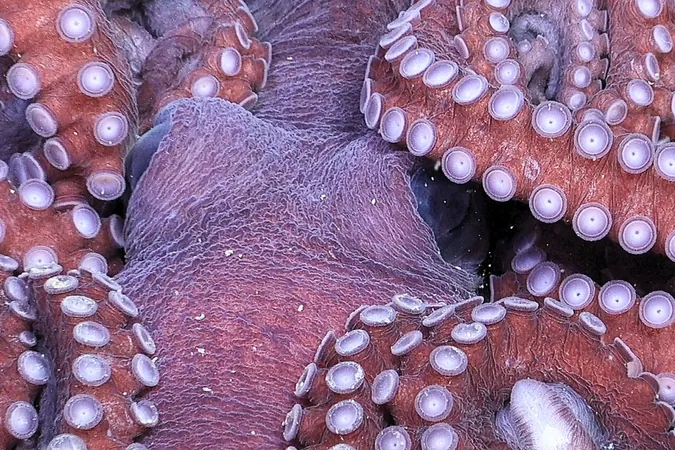
What Scientists Discovered Beneath a Giant Iceberg in Antarctica Will Leave You Speechless!
2025-03-20
Author: Yu
In a groundbreaking expedition, a team of international scientists aboard the Schmidt Ocean Institute's R/V Falkor (too) has unveiled astonishing images and videos of a previously concealed section of the Antarctic seafloor—long hidden beneath thick ice. This remarkable exploration was prompted by the recent calving of the colossal A-84 iceberg, which broke free from the George VI Ice Shelf on January 13, 2025.
To put it into perspective, this iceberg stretches over a staggering 510 square kilometers, nearly the size of Chicago. Its dramatic separation from the ice shelf exposed a vast underwater world that had remained untouched for centuries.
Exploring the Abyss: A Journey into the Unknown
Equipped with advanced technology, including the remotely operated vehicle (ROV) SuBastian, the scientists conducted an intense eight-day survey of the deep-sea environment, diving to depths of up to 1,300 meters. What they uncovered was nothing short of extraordinary—a thriving ecosystem flourishing in eternal darkness.
Dr. Patricia Esquete, one of the lead scientists on the mission, shared her excitement: “We seized upon the moment, changed our expedition plan, and went for it to study what was happening below. We didn’t expect to find such a beautiful, thriving ecosystem. The size of the animals suggests that these communities have persisted for decades, potentially even hundreds of years.”
Among their findings were vibrant corals and sponges, which provided habitats for an array of marine life, including icefish, giant sea spiders, octopuses, and even a colossal phantom jelly, a jellyfish species that can expand to an impressive meter wide, with tentacles measuring over 10 meters long. Intriguingly, the team suspects they may have stumbled upon several species new to science, offering exciting insights into life beneath Antarctica’s ice shelves.
The Mystery of Survival in Darkness
For decades, our understanding of life beneath Antarctica's vast ice cover was limited. This expedition challenges existing knowledge by revealing a biodiverse ecosystem existing in isolation from sunlight and the usual energy sources found in the ocean. The question arises: How do these creatures inhabit such an extreme environment?
While deep-sea ecosystems typically rely on organic materials drifting from the surface, this particular region had been ensconced under thick ice for centuries. Researchers speculate that ocean currents may be carrying vital nutrients to sustain this hidden marine life.
Unveiling Climate Shift Secrets
Beyond the biological treasures, the expedition offers profound insights into Antarctica’s past climate and future repercussions. The researchers are diligently examining geological clues yielded by the melting ice sheets to forecast future ice loss and its implications for global sea levels.
Sasha Montelli, another expedition scientist, emphasized the importance of their work: “The ice loss from the Antarctic Ice Sheet is a major contributor to global sea level rise. Our studies provide a long-term context for these changes, enhancing our ability to make accurate future predictions that can drive actionable policies.”
The team has also deployed autonomous underwater gliders to monitor how glacial meltwater is affecting the region's ocean chemistry and currents. Initial results point to increased biological productivity, alongside a notable influx of meltwater from the retreating ice shelf.
This remarkable mission is part of Challenger 150, a UNESCO-endorsed initiative dedicated to deep-sea exploration. Schmidt Ocean Institute’s Executive Director, Dr. Jyotika Virmani, remarked on the serendipity of witnessing the iceberg's calving live: “Such moments are part of the excitement of research at sea; they provide an opportunity to observe our world's untouched beauty.”
As we learn more about the hidden ecosystems beneath the ice, our understanding of life on Earth continues to evolve, reminding us of the mysteries that still await discovery beneath our oceans.

 Brasil (PT)
Brasil (PT)
 Canada (EN)
Canada (EN)
 Chile (ES)
Chile (ES)
 Česko (CS)
Česko (CS)
 대한민국 (KO)
대한민국 (KO)
 España (ES)
España (ES)
 France (FR)
France (FR)
 Hong Kong (EN)
Hong Kong (EN)
 Italia (IT)
Italia (IT)
 日本 (JA)
日本 (JA)
 Magyarország (HU)
Magyarország (HU)
 Norge (NO)
Norge (NO)
 Polska (PL)
Polska (PL)
 Schweiz (DE)
Schweiz (DE)
 Singapore (EN)
Singapore (EN)
 Sverige (SV)
Sverige (SV)
 Suomi (FI)
Suomi (FI)
 Türkiye (TR)
Türkiye (TR)
 الإمارات العربية المتحدة (AR)
الإمارات العربية المتحدة (AR)